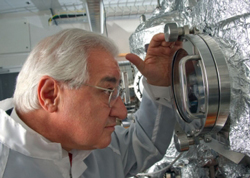- News
14 February 2011
Boston’s Moustakas awarded $1.5m to develop handheld UV laser
 Professor Theodore Moustakas of Boston University’s Department of Electrical & Computer Engineering (ECE) has received a $1.5m, two-year subcontract from the US Defense Advanced Research Projects Agency (DARPA) to help develop a handheld electron-beam-pumped semiconductor laser that would be the first to operate in the ultraviolet (UV) region of the electromagnetic spectrum.
Professor Theodore Moustakas of Boston University’s Department of Electrical & Computer Engineering (ECE) has received a $1.5m, two-year subcontract from the US Defense Advanced Research Projects Agency (DARPA) to help develop a handheld electron-beam-pumped semiconductor laser that would be the first to operate in the ultraviolet (UV) region of the electromagnetic spectrum.
Picture: Moustakas inspecting the growth of nitride-based semiconductor materials.
Because of its ultra-low emission wavelength and compact size, such a laser could be exploited for a wide range of defense and commercial applications, including non-line-of-sight communication in dense urban areas and other military theaters, via airborne particulates that propagate the signal; identification of biological and chemical substances used in potential terror attacks; and point-of-care chemical analyses of blood and other bodily fluids.
To develop the laser technology, Moustakas and two co-investigators (ECE associate professors Roberto Paiella and Luca Dal Negro) will fabricate UV laser materials and component devices; Applied Physics Technologies Inc of McMinnville, OR and NASA’s Jet Propulsion Laboratory (JPL) at the California Institute of Technology (Caltech) in Pasadena, CA will design miniature electron guns to pump the laser, and prime contractor Photon Systems Inc, which makes deep UV laser sources, will integrate everything into a prototype measuring less than 1 cubic inch.
“We plan to make a laser structure that, when bombarded with an electron beam, produces pairs of electrons and holes (positively charged particles), which recombine and produce the UV light,” says Moustakas. “DARPA chose us because we have produced aluminum gallium nitride (AlGaN) alloys in which up to 68% of those electron/hole pairs are converted into light, a conversion efficiency of about 1000 times that of materials produced by other research groups,” he claims.
Using molecular beam epitaxy (MBE), the Boston ECE team will produce the core AlGaN-based laser material and then construct component devices from multiple layers of the material. The researchers will evaluate the materials by directing electron beams at them in the lab.
In parallel with this project, Moustakas is working on a separate grant from NASA to develop a similar laser to perform chemical analyses of soil samples on future Mars expeditions. He is also advancing visible and ultraviolet LEDs and lasers for solid-state white lighting, water and air sterilization, and identification of biological and chemical agents; and indium gallium nitride (InGaN) quantum dots that boost solar cell efficiency.
Veeco/NAMBE 2010 MBE Innovator Award goes to Boston University's Theodore Moustakas
Join Semiconductor Today's group on LinkedIn
